 An increasing number of wealth managers and asset managers are recognizing the importance of search engine optimization (SEO) on their websites for lead generation, brand building, and visibility.
An increasing number of wealth managers and asset managers are recognizing the importance of search engine optimization (SEO) on their websites for lead generation, brand building, and visibility.
For many, the most significant obstacle is not knowing what they don’t know and starting down a path that leads to no leads—or to suboptimal results. Even with the most thorough implementation of an SEO strategy, the results can take months to show. That’s a significant investment of time, energy, and resources to lose if you start down the wrong path.
An impactful SEO strategy has a multitude of moving parts, and it’s not a one-and-done implementation. It requires constant monitoring and optimization to maintain positive results. Before starting any SEO, it’s vital to position your firm and website for success by creating a complete strategy based on what you want to accomplish.
However, before the in-depth, technical work of a complete SEO strategy can begin, it’s critical to lay down six foundational building blocks that, if neglected, will almost guarantee less desirable results or worse, failure.
Here are the six foundational basics of SEO for asset managers and wealth managers:
- Create or Claim Your Google Business Profile
When you search for a brand on Google, the results often include a box to the right of the result. The box is the knowledge panel, which may include a picture of the business and its address. It typically contains links to the website and directions to the business. If you don’t create it, Google Business Profile, formerly Google My Business, will. If you don’t know it’s there, anyone can claim the panel and switch out information.
For example, and this happens on occasion, a competitor or black hat SEO company using tactics not approved by search engine guidelines can come in and change all the information that will keep you from showing up on page one. Or they may suggest incorrect or new categories for your business. Each knowledge panel includes a “suggest edits” button. Anyone can click on it and offer a suggestion. If you haven’t claimed the panel or are unaware of it, Google will accept it. This can muddy the waters, preventing you from appearing in the category of search results you want.
If you’re unaware of or don’t claim your Google Business, you open yourself up to potential shenanigans that can make you invisible on Google. If you don’t check it frequently to ensure your information is current, it can reflect poorly on your business.
To claim your Google Business Profile, you need to have your business verified. When you submit a request to claim it, Google will send you a plain white postcard with a code linked to your business address. Once you input that code on your panel, your business is verified.
GOOGLE BUSINESS PROFILE
Here’s an example of a Google Business Profile for Chase Investment Counsel. Note the “suggest an edit” link at the bottom; if you have not claimed yours, your competitors or scammers can. They can make edits which you will most likely not like
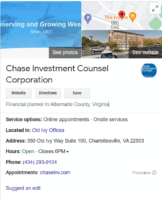
Chase Investment Counsel, founded in 1957, is a family and employee-owned wealth management firm offering personalized investment services throughout Virginia and neighboring states
- Install Google Analytics and Google Search Console
Google Search Console and Google Analytics are separate platform tools that, when used together, can provide valuable insights into the performance of your website. The Google Search Console shows you if your site is indexed with Google, and if it is, you can submit your site map, so it shows in the search results. It will also show your current ranking and where you’re ranking for specific keywords or keyword phrases. You will also see if any of your pages have been disapproved or taken out of search for technical reasons. One of our client’s robot text clearly indicated “no index,” so his entire website was not being indexed because a little piece of code was telling Google not to. They were completely unaware of this.
Google Analytics provides you with a window into visitor behavior on your site. You can see how many visitors your site gets in any given timeframe. It also tells you the source of your visitors, such as from a search, or a link from another website. You can see which pages are attracting the most traffic and where visitors land first when coming to your site.
GOOGLE ANALYTICS
The Google Analytics example below is from a client website; it shows their top five most visited pages for one week. The top line, the home page, was their most popular, with 1,016 pageviews. The firm’s Strategic Income Fund page was their second most visited page with 330 page views.
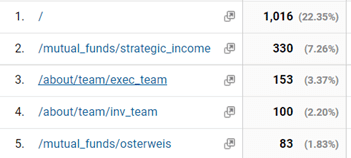
GOOGLE SEARCH CONSOLE
The image below tells us how many times a site showed up in Google Search Results (Google calls them “impressions”)—and how many times someone clicked a link to visit the site. The site received 586 clicks to the site from Google search in one month. These are good number for a niche market. However, improvement should always be sought.
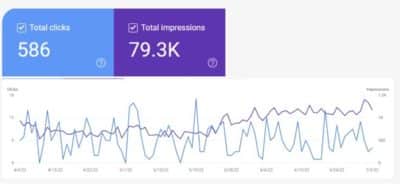
- Perform a Site Audit
Performing a site audit is like taking your car in for an oil change and a 30-point inspection to prevent future problems. If you wait until you hear the engine knocking, you’re looking at a major problem and a large repair bill. The same goes for your website. You need to check under the hood regularly to see if there might be some critical errors that could be affecting your users’ experience or holding your website back from getting good search rankings.
The first thing to check for is broken links that could be linking your users to nowhere. That’s a sure way to lose credibility. Another critical metric is site speed—how fast your pages load. Slow-loading pages, often unnoticed by visitors, are a turnoff, and Google doesn’t take too kindly to it when determining your ranking for essential keywords. An audit will also inform you if your robot text may be blocking search engines from indexing your site or missing any backend optimization components needed to rank well in the search engines. A periodic site audit is essential to ensure it is performing optimally.
Without a regular checkup, your website might in fact be holding you back. For a complimentary website audit and recommendations, please Sondhelm Partners.
Google and SEMRush also offer a free website audit that measures most of the critical components. For a deeper dive, some paid tools will provide a more in-depth assessment. (You can use our free website audit tool here.)
SITE AUDIT
Below is an example of a site audit overview from SEMRush. This website had a Site Health score of 75% (100% is the best). The top 10 of all websites scored 92% or better. The Errors, Warnings and Notices help you rank the comparative importance of items that you need to address. Errors are the most critical (examples: missing links and duplicate text); followed by Warnings (incorrect JavaScript and missing headings); and Notices (too few backlinks.)
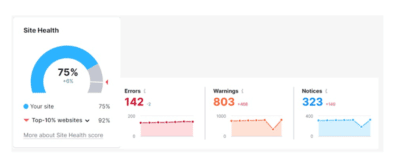
- Fix Missing or Wrong Meta-Tags
A meta-tag, which consists of a meta-title and meta-description, is the text displayed in search results. The title or headline with the larger font is shown first in the search result, and the description is the one or two sentences you see below. Well-conceived meta-tags are essential for achieving good page rankings. They’re also important because, if you don’t include them, Google will come up with something likely to be irrelevant and far less flattering, such as random snippets from the article content, ensuring your article will get buried in the rankings.
You need to fix the settings in the back end of your website to recognize your content’s title as the meta-title. The meta-description is limited to 160 characters; the more, the better to ensure as complete a description as possible without going over.
META-TAGS
Here’s an example of a meta title and meta description from Google Search results. The blue heading “Greenwood Capital Wealth Management, Investment …” is the meta title. The text “Greenwood Capital brings a 50-year history…” is the meta description.

- Fix Errors and Broken Links
We briefly mentioned broken links as part of the site audit step. We emphasize it as a separate step because this error is crucial to the integrity of your website. Broken links that lead users to nowhere reflect the quality of your website and your business’s credibility. Plus, they’re easy to miss. Regular quality control checks of all the links on your site should be at least a quarterly regimen.
The “Errors” screenshot below from SEMRush shows 117 broken internal links for one website, six with duplicate title tags, six pages with duplicate content issues, and so on. The goal is to have zero broken links, and no other issues as well. These errors and broken links damage both your trustworthiness and your search rankings.
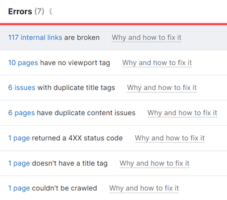
- Check Your Site Speed
Site speed needs to be checked frequently, especially as you add new pages or graphics. Also, site owners need to work constantly to improve site speed where they can, as it helps to improve their ranking with Google. As with broken links, slow-loading pages can affect a site’s credibility. Checking images that may need to be compressed is also essential.
Improving site page speed is not an easy task. That may be beyond the technical ability of most people.
SITE SPEED PERFOMANCE
The screenshot below, from Google Page Speed Insights, shows that the website analyzed scored only 46 out of 100 for page speed. Google takes speed into account when ranking pages.
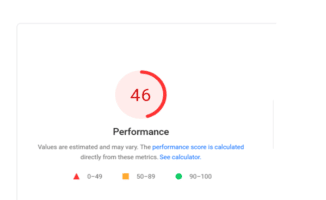
Building on the Foundation
It’s important to reiterate that laying the foundation with these six steps is not a “set it and forget” proposition. The only constant with SEO is constant change. Your website requires continuous monitoring and optimization, often requiring tweaks. That’s critical because Google is constantly updating its algorithms.
What was working last month may not work as well this month. Or your competitor hires an SEO specialist, and one day you find your site knocked down in the rankings because they have a more effective strategy.
While implementing these six foundational steps is crucial just to get into the SEO game, you’ll need a more in-depth, technical strategy to achieve a high ranking and stay there. That’s where hiring an SEO strategist pays off. In terms of your total marketing outlay, there may be no better ROI than a fully optimized website that puts you on top of the search engine rankings for the keywords that can help you grow your business.
Asset managers and wealth managers: are you ready to be found?
Dan Sondhelm is CEO of Sondhelm Partners, a firm that helps asset managers, mutual funds, ETFs, wealth managers and fintech companies grow through marketing, public relations, and sales programs. Click to read Dan’s latest Insight articles and to schedule a complimentary consultation.
Connect

